Marketing, lecture 7 ass. prof. I. I. Skorobogatykh

















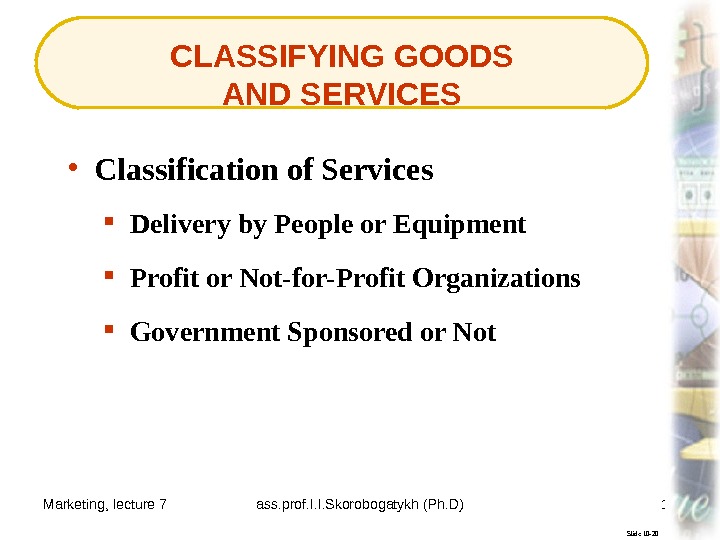






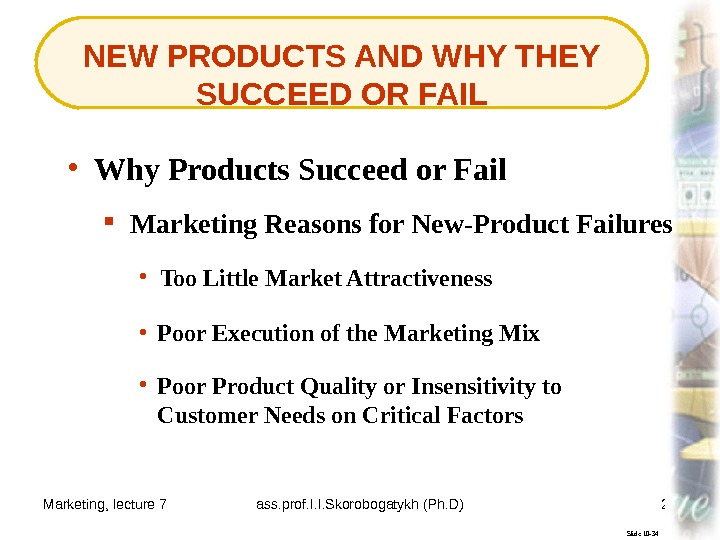

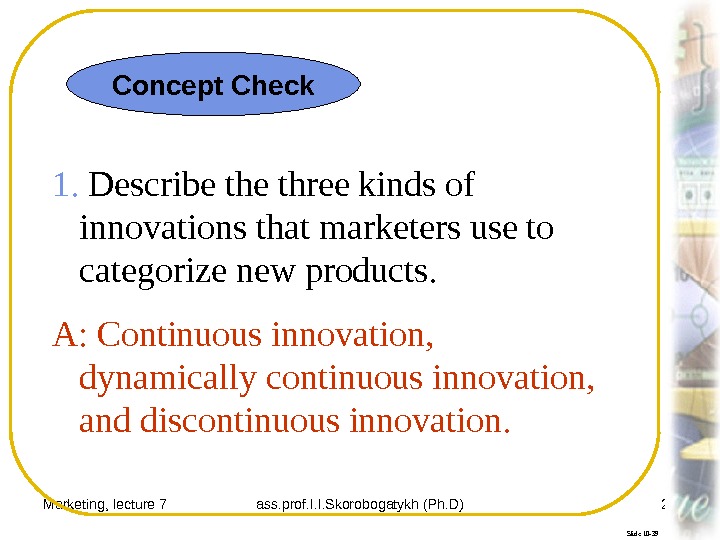



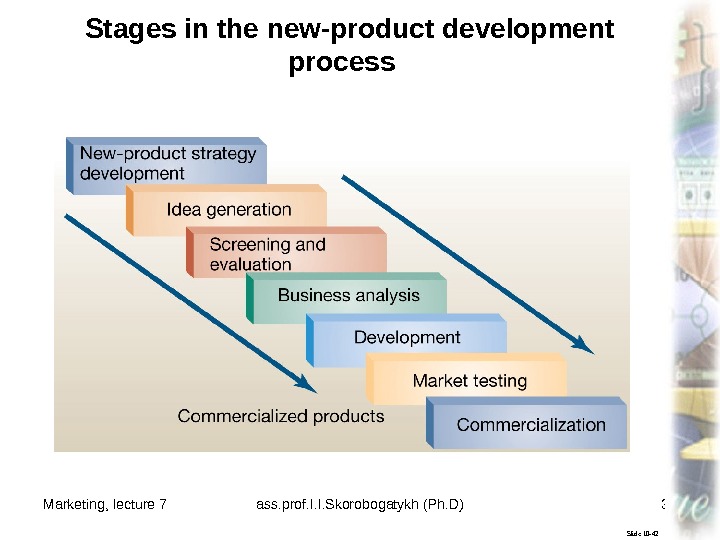






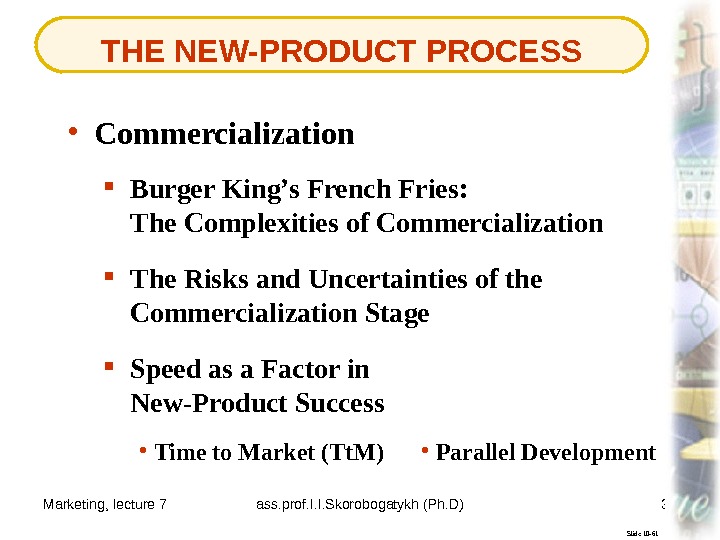




- Размер: 3.6 Mегабайта
- Количество слайдов: 41
Описание презентации Marketing, lecture 7 ass. prof. I. I. Skorobogatykh по слайдам
 Marketing, lecture 7 ass. prof. I. I. Skorobogatykh (Ph. D) 1 Slide 10 -2 DEVELOPING NEW PRODUCTS AND SERVICESC HAPTERLecture 7_New product development Associate professor of Plekhanov REA Marketing department Irina I. Skorobogatykh (Ph. D)
Marketing, lecture 7 ass. prof. I. I. Skorobogatykh (Ph. D) 1 Slide 10 -2 DEVELOPING NEW PRODUCTS AND SERVICESC HAPTERLecture 7_New product development Associate professor of Plekhanov REA Marketing department Irina I. Skorobogatykh (Ph. D)
 Marketing, lecture 7 ass. prof. I. I. Skorobogatykh (Ph. D) 2 Slide 10 -5 LECTURE QUESTIONS: • Identify the consumer and business goods and services are classified and marketed. • Explain the effects of different ways of viewing “newness” in new products and services.
Marketing, lecture 7 ass. prof. I. I. Skorobogatykh (Ph. D) 2 Slide 10 -5 LECTURE QUESTIONS: • Identify the consumer and business goods and services are classified and marketed. • Explain the effects of different ways of viewing “newness” in new products and services.
 Marketing, lecture 7 ass. prof. I. I. Skorobogatykh (Ph. D) 3 Slide 10 -6 LECTURE QUESTIONS: • Analyze the factors that contribute to the success or failure of a product or service. • Describe the purposes of each step of the new-product process.
Marketing, lecture 7 ass. prof. I. I. Skorobogatykh (Ph. D) 3 Slide 10 -6 LECTURE QUESTIONS: • Analyze the factors that contribute to the success or failure of a product or service. • Describe the purposes of each step of the new-product process.
 Marketing, lecture 7 ass. prof. I. I. Skorobogatykh (Ph. D) 4 THE VARIATIONS OF PRODUCTS Slide 10 -10 • Product Line and Product Mix Product Line Product Mix • Product Item • Stock Keeping Unit (SKU)
Marketing, lecture 7 ass. prof. I. I. Skorobogatykh (Ph. D) 4 THE VARIATIONS OF PRODUCTS Slide 10 -10 • Product Line and Product Mix Product Line Product Mix • Product Item • Stock Keeping Unit (SKU)
 Marketing, lecture 7 ass. prof. I. I. Skorobogatykh (Ph. D) 5 Slide 10 -92 A product is a good, service, or idea consisting of a bundle of tangible and intangible attributes that satisfies consumers and is received in exchange for money or some other unit of value. Product
Marketing, lecture 7 ass. prof. I. I. Skorobogatykh (Ph. D) 5 Slide 10 -92 A product is a good, service, or idea consisting of a bundle of tangible and intangible attributes that satisfies consumers and is received in exchange for money or some other unit of value. Product
 Marketing, lecture 7 ass. prof. I. I. Skorobogatykh (Ph. D) 6 Slide 10 -93 A product line is a group of products— goods or services—that are closely related because they satisfy a class of needs, are used together, are sold to the same customer group, are distributed through the same type of outlets, or fall w/in a given price range. Product Line
Marketing, lecture 7 ass. prof. I. I. Skorobogatykh (Ph. D) 6 Slide 10 -93 A product line is a group of products— goods or services—that are closely related because they satisfy a class of needs, are used together, are sold to the same customer group, are distributed through the same type of outlets, or fall w/in a given price range. Product Line
 Marketing, lecture 7 ass. prof. I. I. Skorobogatykh (Ph. D) 7 Slide 10 -94 The product mix is the number of product lines offered by a company. Product Mix
Marketing, lecture 7 ass. prof. I. I. Skorobogatykh (Ph. D) 7 Slide 10 -94 The product mix is the number of product lines offered by a company. Product Mix
 Marketing, lecture 7 ass. prof. I. I. Skorobogatykh (Ph. D) 8 THE VARIATIONS OF PRODUCTS Slide 10 -12 • Classifying Products Type of User Degree of Tangibility • Consumer Goods • Business Goods • Nondurable Good • Durable Good • Services
Marketing, lecture 7 ass. prof. I. I. Skorobogatykh (Ph. D) 8 THE VARIATIONS OF PRODUCTS Slide 10 -12 • Classifying Products Type of User Degree of Tangibility • Consumer Goods • Business Goods • Nondurable Good • Durable Good • Services
 Marketing, lecture 7 ass. prof. I. I. Skorobogatykh (Ph. D) 9 Slide 10 -95 Consumer goods are products purchased by the ultimate consumer. Consumer Goods
Marketing, lecture 7 ass. prof. I. I. Skorobogatykh (Ph. D) 9 Slide 10 -95 Consumer goods are products purchased by the ultimate consumer. Consumer Goods
 Marketing, lecture 7 ass. prof. I. I. Skorobogatykh (Ph. D) 10 Slide 10 -96 Business goods are products that assist directly or indirectly in providing products for resale. Business Goods
Marketing, lecture 7 ass. prof. I. I. Skorobogatykh (Ph. D) 10 Slide 10 -96 Business goods are products that assist directly or indirectly in providing products for resale. Business Goods
 Marketing, lecture 7 ass. prof. I. I. Skorobogatykh (Ph. D) 11 THE VARIATIONS OF PRODUCTS Slide 10 -14 • The Uniqueness of Services Intangibility Inconsistency • Idle Production Capacity Inseparability Inventory
Marketing, lecture 7 ass. prof. I. I. Skorobogatykh (Ph. D) 11 THE VARIATIONS OF PRODUCTS Slide 10 -14 • The Uniqueness of Services Intangibility Inconsistency • Idle Production Capacity Inseparability Inventory
 Marketing, lecture 7 ass. prof. I. I. Skorobogatykh (Ph. D) 12 Slide 10 -97 Idle production capacity is when the service provider is available but there is no demand. Idle Production Capacity
Marketing, lecture 7 ass. prof. I. I. Skorobogatykh (Ph. D) 12 Slide 10 -97 Idle production capacity is when the service provider is available but there is no demand. Idle Production Capacity
 Marketing, lecture 7 ass. prof. I. I. Skorobogatykh (Ph. D) 13 Slide 10 -15 The 4 I’s of service
Marketing, lecture 7 ass. prof. I. I. Skorobogatykh (Ph. D) 13 Slide 10 -15 The 4 I’s of service
 Marketing, lecture 7 ass. prof. I. I. Skorobogatykh (Ph. D) 14 CLASSIFYING GOODS AND SERVICES Slide 10 -16 • Classification of Consumer Goods Convenience Goods Shopping Goods Specialty Goods Unsought Goods
Marketing, lecture 7 ass. prof. I. I. Skorobogatykh (Ph. D) 14 CLASSIFYING GOODS AND SERVICES Slide 10 -16 • Classification of Consumer Goods Convenience Goods Shopping Goods Specialty Goods Unsought Goods
 Marketing, lecture 7 ass. prof. I. I. Skorobogatykh (Ph. D) 15 Slide 10 -17 Classification of consumer goods
Marketing, lecture 7 ass. prof. I. I. Skorobogatykh (Ph. D) 15 Slide 10 -17 Classification of consumer goods
 Marketing, lecture 7 ass. prof. I. I. Skorobogatykh (Ph. D) 16 CLASSIFYING GOODS AND SERVICES Slide 10 -19 • Classification of Business Goods Derived Demand Production Goods Support Goods • Installations • Accessory Equipment • Supplies • Services
Marketing, lecture 7 ass. prof. I. I. Skorobogatykh (Ph. D) 16 CLASSIFYING GOODS AND SERVICES Slide 10 -19 • Classification of Business Goods Derived Demand Production Goods Support Goods • Installations • Accessory Equipment • Supplies • Services
 Marketing, lecture 7 ass. prof. I. I. Skorobogatykh (Ph. D) 17 CLASSIFYING GOODS AND SERVICES Slide 10 -20 • Classification of Services Delivery by People or Equipment Profit or Not-for-Profit Organizations Government Sponsored or Not
Marketing, lecture 7 ass. prof. I. I. Skorobogatykh (Ph. D) 17 CLASSIFYING GOODS AND SERVICES Slide 10 -20 • Classification of Services Delivery by People or Equipment Profit or Not-for-Profit Organizations Government Sponsored or Not
 Marketing, lecture 7 ass. prof. I. I. Skorobogatykh (Ph. D) 18 Slide 10 -23 1. Explain the difference between product mix and product line. A: The product mix is the number of product lines offered by a company. A product line is a group of products or services that: satisfy a class of needs, are used together, are sold to the same customer group, are distributed through the same outlets, or fall within a given price range. Concept Check
Marketing, lecture 7 ass. prof. I. I. Skorobogatykh (Ph. D) 18 Slide 10 -23 1. Explain the difference between product mix and product line. A: The product mix is the number of product lines offered by a company. A product line is a group of products or services that: satisfy a class of needs, are used together, are sold to the same customer group, are distributed through the same outlets, or fall within a given price range. Concept Check
 Marketing, lecture 7 ass. prof. I. I. Skorobogatykh (Ph. D) 19 Slide 10 -24 2. What are the four main types of consumer goods? A: Convenience goods, shopping goods, specialty goods, and unsought goods. Concept Check
Marketing, lecture 7 ass. prof. I. I. Skorobogatykh (Ph. D) 19 Slide 10 -24 2. What are the four main types of consumer goods? A: Convenience goods, shopping goods, specialty goods, and unsought goods. Concept Check
 Marketing, lecture 7 ass. prof. I. I. Skorobogatykh (Ph. D) 20 Slide 10 -25 3. What are three ways to classify services? A: Delivery by people or equipment, profit or not-for-profit organizations, and government sponsored or not. Concept Check
Marketing, lecture 7 ass. prof. I. I. Skorobogatykh (Ph. D) 20 Slide 10 -25 3. What are three ways to classify services? A: Delivery by people or equipment, profit or not-for-profit organizations, and government sponsored or not. Concept Check
 Marketing, lecture 7 ass. prof. I. I. Skorobogatykh (Ph. D) 21 NEW PRODUCTS AND WHY THEY SUCCEED OR FAIL Slide 10 -26 • What is a New Product? The Term “New” Continuous Innovation Dynamically Continuous Innovation Discontinuous Innovation
Marketing, lecture 7 ass. prof. I. I. Skorobogatykh (Ph. D) 21 NEW PRODUCTS AND WHY THEY SUCCEED OR FAIL Slide 10 -26 • What is a New Product? The Term “New” Continuous Innovation Dynamically Continuous Innovation Discontinuous Innovation
 Marketing, lecture 7 ass. prof. I. I. Skorobogatykh (Ph. D) 22 Slide 10 -29 Product “newness, ” as defined by the degree of consumer learning needed to use the product
Marketing, lecture 7 ass. prof. I. I. Skorobogatykh (Ph. D) 22 Slide 10 -29 Product “newness, ” as defined by the degree of consumer learning needed to use the product
 Marketing, lecture 7 ass. prof. I. I. Skorobogatykh (Ph. D) 23 NEW PRODUCTS AND WHY THEY SUCCEED OR FAIL Slide 10 -30 • Why Products Succeed or Fail Marketing Reasons for New-Product Failures • Incomplete Market and Product Definition Before Product Development Starts • Insignificant Point of Difference
Marketing, lecture 7 ass. prof. I. I. Skorobogatykh (Ph. D) 23 NEW PRODUCTS AND WHY THEY SUCCEED OR FAIL Slide 10 -30 • Why Products Succeed or Fail Marketing Reasons for New-Product Failures • Incomplete Market and Product Definition Before Product Development Starts • Insignificant Point of Difference
 Marketing, lecture 7 ass. prof. I. I. Skorobogatykh (Ph. D) 24 NEW PRODUCTS AND WHY THEY SUCCEED OR FAIL Slide 10 -34 • Why Products Succeed or Fail Marketing Reasons for New-Product Failures • Too Little Market Attractiveness • Poor Execution of the Marketing Mix • Poor Product Quality or Insensitivity to Customer Needs on Critical Factors
Marketing, lecture 7 ass. prof. I. I. Skorobogatykh (Ph. D) 24 NEW PRODUCTS AND WHY THEY SUCCEED OR FAIL Slide 10 -34 • Why Products Succeed or Fail Marketing Reasons for New-Product Failures • Too Little Market Attractiveness • Poor Execution of the Marketing Mix • Poor Product Quality or Insensitivity to Customer Needs on Critical Factors
 Marketing, lecture 7 ass. prof. I. I. Skorobogatykh (Ph. D) 25 NEW PRODUCTS AND WHY THEY SUCCEED OR FAIL Slide 10 -35 • Why Products Succeed or Fail Marketing Reasons for New-Product Failures • Bad Timing • No Economic Access to Buyers A Look at Some Failures
Marketing, lecture 7 ass. prof. I. I. Skorobogatykh (Ph. D) 25 NEW PRODUCTS AND WHY THEY SUCCEED OR FAIL Slide 10 -35 • Why Products Succeed or Fail Marketing Reasons for New-Product Failures • Bad Timing • No Economic Access to Buyers A Look at Some Failures
 Marketing, lecture 7 ass. prof. I. I. Skorobogatykh (Ph. D) 26 Slide 10 -39 1. Describe three kinds of innovations that marketers use to categorize new products. A: Continuous innovation, dynamically continuous innovation, and discontinuous innovation. Concept Check
Marketing, lecture 7 ass. prof. I. I. Skorobogatykh (Ph. D) 26 Slide 10 -39 1. Describe three kinds of innovations that marketers use to categorize new products. A: Continuous innovation, dynamically continuous innovation, and discontinuous innovation. Concept Check
 Marketing, lecture 7 ass. prof. I. I. Skorobogatykh (Ph. D) 27 Slide 10 -40 2. What does “insignificant point of difference” mean as a reason for new-product failure? A: The product’s characteristics did not deliver benefits to the user that were uniquely superior to those of competitors or were not deemed important to users. Concept Check
Marketing, lecture 7 ass. prof. I. I. Skorobogatykh (Ph. D) 27 Slide 10 -40 2. What does “insignificant point of difference” mean as a reason for new-product failure? A: The product’s characteristics did not deliver benefits to the user that were uniquely superior to those of competitors or were not deemed important to users. Concept Check
 Marketing, lecture 7 ass. prof. I. I. Skorobogatykh (Ph. D) 28 THE NEW-PRODUCT DEVELOPMENT PROCESS Slide 10 -41 • New-Product Development Process Identifying Markets and Strategic Roles • Cross-Functional Teams • New-Product Strategy Development Cross-Functional Teams and New-Product Development
Marketing, lecture 7 ass. prof. I. I. Skorobogatykh (Ph. D) 28 THE NEW-PRODUCT DEVELOPMENT PROCESS Slide 10 -41 • New-Product Development Process Identifying Markets and Strategic Roles • Cross-Functional Teams • New-Product Strategy Development Cross-Functional Teams and New-Product Development
 Marketing, lecture 7 ass. prof. I. I. Skorobogatykh (Ph. D) 29 Slide 10 -98 The new-product development process consists of seven stages a firm goes through to identify business opportunities and convert them to a salable good or service. New-Product Development Process
Marketing, lecture 7 ass. prof. I. I. Skorobogatykh (Ph. D) 29 Slide 10 -98 The new-product development process consists of seven stages a firm goes through to identify business opportunities and convert them to a salable good or service. New-Product Development Process
 Marketing, lecture 7 ass. prof. I. I. Skorobogatykh (Ph. D) 30 Slide 10 -42 Stages in the new-product development process
Marketing, lecture 7 ass. prof. I. I. Skorobogatykh (Ph. D) 30 Slide 10 -42 Stages in the new-product development process
 Marketing, lecture 7 ass. prof. I. I. Skorobogatykh (Ph. D) 31 Slide 10 -44 The cross-functional new-product team
Marketing, lecture 7 ass. prof. I. I. Skorobogatykh (Ph. D) 31 Slide 10 -44 The cross-functional new-product team
 Marketing, lecture 7 ass. prof. I. I. Skorobogatykh (Ph. D) 32 THE NEW-PRODUCT PROCESS Slide 10 -52 Internal Approach • Screening and Evaluation External Approach • Concept Tests
Marketing, lecture 7 ass. prof. I. I. Skorobogatykh (Ph. D) 32 THE NEW-PRODUCT PROCESS Slide 10 -52 Internal Approach • Screening and Evaluation External Approach • Concept Tests
 Marketing, lecture 7 ass. prof. I. I. Skorobogatykh (Ph. D) 33 Slide 10 -54 1. What step in the new-product process has been added in recent years? A: New-product strategy development has been added recently by many companies to provide focus for ideas and concepts developed in later stages. Concept Check
Marketing, lecture 7 ass. prof. I. I. Skorobogatykh (Ph. D) 33 Slide 10 -54 1. What step in the new-product process has been added in recent years? A: New-product strategy development has been added recently by many companies to provide focus for ideas and concepts developed in later stages. Concept Check
 Marketing, lecture 7 ass. prof. I. I. Skorobogatykh (Ph. D) 34 Slide 10 -55 2. What are four sources of new-product ideas? A: Customer and supplier suggestions, employee suggestions, R&D breakthroughs, and competitive products. Concept Check
Marketing, lecture 7 ass. prof. I. I. Skorobogatykh (Ph. D) 34 Slide 10 -55 2. What are four sources of new-product ideas? A: Customer and supplier suggestions, employee suggestions, R&D breakthroughs, and competitive products. Concept Check
 Marketing, lecture 7 ass. prof. I. I. Skorobogatykh (Ph. D) 35 THE NEW-PRODUCT PROCESS Slide 10 -56 Prototype • Business Analysis Assessing the “Business Fit” of the New Product Big G Plus Pillsbury: Increasing Emphasis on Synergies and Segments
Marketing, lecture 7 ass. prof. I. I. Skorobogatykh (Ph. D) 35 THE NEW-PRODUCT PROCESS Slide 10 -56 Prototype • Business Analysis Assessing the “Business Fit” of the New Product Big G Plus Pillsbury: Increasing Emphasis on Synergies and Segments
 Marketing, lecture 7 ass. prof. I. I. Skorobogatykh (Ph. D) 36 THE NEW-PRODUCT PROCESS Slide 10 -58 Test Marketing • Development • Market Testing When Test Markets Don’t Work
Marketing, lecture 7 ass. prof. I. I. Skorobogatykh (Ph. D) 36 THE NEW-PRODUCT PROCESS Slide 10 -58 Test Marketing • Development • Market Testing When Test Markets Don’t Work
 Marketing, lecture 7 ass. prof. I. I. Skorobogatykh (Ph. D) 37 THE NEW-PRODUCT PROCESS Slide 10 -61 • Commercialization Speed as a Factor in New-Product Success Burger King’s French Fries: The Complexities of Commercialization The Risks and Uncertainties of the Commercialization Stage • Time to Market (Tt. M) • Parallel Development
Marketing, lecture 7 ass. prof. I. I. Skorobogatykh (Ph. D) 37 THE NEW-PRODUCT PROCESS Slide 10 -61 • Commercialization Speed as a Factor in New-Product Success Burger King’s French Fries: The Complexities of Commercialization The Risks and Uncertainties of the Commercialization Stage • Time to Market (Tt. M) • Parallel Development
 Marketing, lecture 7 ass. prof. I. I. Skorobogatykh (Ph. D) 38 Slide 10 -62 Marketing information and methods used in the new-product process
Marketing, lecture 7 ass. prof. I. I. Skorobogatykh (Ph. D) 38 Slide 10 -62 Marketing information and methods used in the new-product process
 Marketing, lecture 7 ass. prof. I. I. Skorobogatykh (Ph. D) 39 Slide 10 -65 1. Describe the business analysis stage of the new-product process. A: Business analysis involves specifying the features of the product and the marketing strategy needed to commercialize it—bring it to market—and making financial projections. Concept Check
Marketing, lecture 7 ass. prof. I. I. Skorobogatykh (Ph. D) 39 Slide 10 -65 1. Describe the business analysis stage of the new-product process. A: Business analysis involves specifying the features of the product and the marketing strategy needed to commercialize it—bring it to market—and making financial projections. Concept Check
 Marketing, lecture 7 ass. prof. I. I. Skorobogatykh (Ph. D) 40 Slide 10 -66 2. What is a test market? A: A test market is a city that is viewed as being representative of U. S. consumers in terms of demographics and brand purchase patterns, is far enough from big markets to allow low-cost advertising, and has tracking systems to measure sales. Concept Check
Marketing, lecture 7 ass. prof. I. I. Skorobogatykh (Ph. D) 40 Slide 10 -66 2. What is a test market? A: A test market is a city that is viewed as being representative of U. S. consumers in terms of demographics and brand purchase patterns, is far enough from big markets to allow low-cost advertising, and has tracking systems to measure sales. Concept Check
 Marketing, lecture 7 ass. prof. I. I. Skorobogatykh (Ph. D) 41 Slide 10 -67 3. What is commercialization of a new product? A: Commercialization involves positioning and launching a new product in full-scale production and sales and is the most expensive stage for most new products. Concept Check
Marketing, lecture 7 ass. prof. I. I. Skorobogatykh (Ph. D) 41 Slide 10 -67 3. What is commercialization of a new product? A: Commercialization involves positioning and launching a new product in full-scale production and sales and is the most expensive stage for most new products. Concept Check

